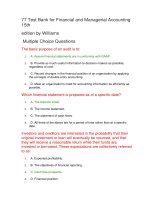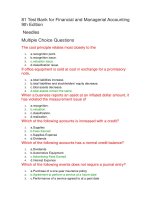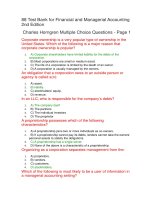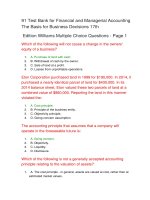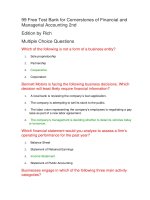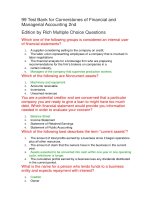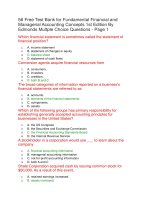TEST BANK FINANCIAL AND MANAGERIAL ACCOUNTING THE BASIS FOR BUSINESS DECISIONS 17TH EDITIONChap002
Bạn đang xem bản rút gọn của tài liệu. Xem và tải ngay bản đầy đủ của tài liệu tại đây (2.4 MB, 332 trang )
Chapter 02
Basic Financial Statements
True / False Questions
1. The sale of additional shares of capital stock will cause treasury stock to increase.
True
False
2. A business entity is regarded as separate from the personal activities of its owners
whether it is a sole proprietorship, a partnership, or a corporation.
True
False
3. Assets need not always have physical characteristics as do buildings, machinery, or
inventory.
True
False
4. The going concern principle assumes that the business will continue indefinitely.
True
False
5. Notes payable and accounts payable both require a company to pay an amount owed
by a certain date. Notes payable generally have interest, while accounts payable
generally do not.
True
False
6. Any business event that might affect the future profitability of a business should be
reported in its balance sheet.
True
False
7. The practice of showing assets on the balance sheet at their cost, rather than at their
current market value is explained, in part, by the fact that cost is supported by
objective evidence that can be verified by independent experts.
True
False
2-1
Copyright © 2015 McGraw-Hill Education. All rights reserved. No reproduction or distribution without the prior written consent of
McGraw-Hill Education.
8. Liabilities are usually listed in order of magnitude, from smallest dollar amount to
largest dollar amount.
True
False
9. The entity principle states that the affairs of the owners are not part of the financial
operations of a business entity and should be separated.
True
False
10. The accounting equation may be stated as "assets minus liabilities equals owners'
equity."
True
False
11. Total assets plus total liabilities must equal total owners' equity.
True
False
12. A transaction that causes an increase in an asset may also cause a decrease in
another asset, an increase in a liability, or an increase in owners' equity.
True
False
13. The collection of an account receivable will cause total assets to decrease.
True
False
14. The payment of a liability causes an increase in owners' equity.
True
False
15. When a business borrows money from a bank, the immediate effect is an increase in
total assets and a decrease in liabilities or owners' equity.
True
False
16. The purchase of an asset, such as office equipment, for cash will cause owners'
equity to decrease.
True
False
17. Total assets must always equal total liabilities plus total owners' equity.
True
False
18. If a company purchases equipment with cash, its total assets will increase.
True
False
2-2
Copyright © 2015 McGraw-Hill Education. All rights reserved. No reproduction or distribution without the prior written consent of
McGraw-Hill Education.
19. If a company purchases equipment by issuing a note payable, its total assets will not
change.
True
False
20. A net profit results from having more revenues than liabilities.
True
False
21. A statement of cash flows reports revenue and expense activities for a specific time
period such as one month or one year.
True
False
22. It is not unusual for an entity to report a significant increase in cash from operating
activities, but a decrease in the total amount of cash.
True
False
23. The statement of cash flows provides a link between two balance sheets by showing
how net income (or loss) has changed owners' equity from one balance sheet date to
the next.
True
False
24. Articulation between the financial statements means that they relate closely to each
other on the basis of the same underlying transaction information.
True
False
25. Limited liability means that owners of a business are only liable for the debts of the
business up to the amounts they can afford.
True
False
26. In a business organized as a corporation, it is not necessary to list the equity of each
stockholder on the balance sheet.
True
False
27. The owner of a sole proprietorship is personally liable for the debts of the business,
whereas the stockholders of a corporation are not personally liable for the debts of
the business.
True
False
2-3
Copyright © 2015 McGraw-Hill Education. All rights reserved. No reproduction or distribution without the prior written consent of
McGraw-Hill Education.
28. Window dressing occurs when management attempts to make a company look
financially stronger than it actually is.
True
False
29. Decision makers outside the organization base their credit decisions on weekly, or
even daily, financial statements.
True
False
30. The major outgrowth from business failures and allegations of fraudulent financial
reporting during the 1990's was the passage of the Securities and Exchange Act.
True
False
Multiple Choice Questions
31. Which of the following is the primary objective of an income statement?
A.
B.
C.
D.
Providing managers with detailed information about where the enterprise stands a
Providing users outside the business organization with information about the comp
Reporting to the Internal Revenue Service the company's taxable income.
Indicating to investors in a particular company the current market values of their
32. Which of the following describes the proper form of a balance sheet?
A.
B.
C.
D.
The heading sets forth the period of time covered.
Cash is always the first asset listed, followed by permanent assets (such as land a
Liabilities are listed before owners' equity.
A subtotal for total assets plus total liabilities is shown.
33. A balance sheet is designed to show:
A.
B.
C.
D.
How much a business is worth.
The profitability of the business during the current year.
The assets, liabilities, and owners' equity of a business as of a particular date
The cost of replacing the assets and of paying off the liabilities at December 3
2-4
Copyright © 2015 McGraw-Hill Education. All rights reserved. No reproduction or distribution without the prior written consent of
McGraw-Hill Education.
34. Blue Wholesale Shirt Co. sold shirts to Pink Retail Shoppe. The owner of Pink Retail
said she would pay Blue at a later date, which Blue Wholesale agreed to. Blue
Wholesale Shirt Co. is considered to be a:
A.
B.
C.
D.
35. Which of the following best defines an asset?
A.
B.
C.
D.
Something with physical form that is valued at cost in the accounting records.
An economic resource owned by a business and expected to benefit future opera
An economic resource representing cash or the right to receive cash in the near
Something owned by a business that has a ready market value.
36. From an accounting viewpoint, when is a business considered as an entity separate
from its owner(s)?
A.
B.
C.
D.
Only when organized as a sole proprietorship.
Only when organized as a partnership.
Only when organized as a corporation.
A business is always considered as an accounting entity separate from the activit
37. The accounting principle that assumes that a company will operate in the foreseeable
future is:
A.
B.
C.
D.
38. The valuation of assets in the balance sheet is based primarily upon:
A.
B.
C.
D.
What it would cost to replace the assets.
Cost, because cost is usually factual and verifiable.
Current fair market value as established by independent appraisers.
Cost, because in the event of liquidation, the assets would be sold at an amount e
2-5
Copyright © 2015 McGraw-Hill Education. All rights reserved. No reproduction or distribution without the prior written consent of
McGraw-Hill Education.
39. Which of the following is not a generally accepted accounting principle relating to the
valuation of assets?
A.
B.
C.
D.
The cost principle - in general, assets are valued at cost, rather than at estimated
The objectivity principle - accountants prefer to use objective, rather than subjecti
The safety principle - assets are valued at no more than the value for which they
The going-concern assumption - one reason for valuing assets such as buildings a
40. Each year, the accountant for Southern Real Estate Company adjusts the recorded
value of each asset to its market value. Using these market value figures on the
balance sheet violates:
A.
B.
C.
D.
The accounting equation.
The stable-dollar assumption.
The business entity concept.
41. The owner of Westhampton Fish Eatery purchased a new car for his daughter who is
away at college at a cost of $43,000 and reported this amount as Delivery Vehicle in
the restaurant's balance sheet. The reporting of this item in this manner violated
the:
A.
B.
C.
D.
Business entity concept.
Objectivity principl
Going-concern assumption.
42. Eton Corporation purchased land in 1998 for $190,000. In 2014, it purchased a nearly
identical parcel of land for $430,000. In its 2014 balance sheet, Eton valued these
two parcels of land at a combined value of $860,000. Reporting the land in this
manner violated the:
A.
B.
C.
D.
Principle of the business entity.
Objectivity principl
Going-concern assumption.
2-6
Copyright © 2015 McGraw-Hill Education. All rights reserved. No reproduction or distribution without the prior written consent of
McGraw-Hill Education.
43. Bob Bertolucci, owner of Bob's Bazaar, also owns a personal residence that costs
$575,000. The market value of his residence is $725,000. During preparation of the
financial statements for Bob's Bazaar, the accounting principle most relevant to the
presentation of Bob's home is:
A.
B.
C.
D.
The concept of the business entity.
The cost princip
The going-concern assumption.
The objectivity principle.
44. Which of the following will not cause a change in the owners' equity of a business?
A.
B.
C.
D.
Purchase of land with cash.
Withdrawal of cash by the owner.
Sale of land at a profit.
Losses from unprofitable operations.
45. Which of the following is correct when a corporation uses cash to pay for an
expense?
A.
B.
C.
D.
Total assets will decrease.
Retained earnings will increase.
Owners' equity will increase.
Liabilities will increase.
46. Deerpark Corporation recently borrowed $70,000 cash from its bank. Which of the
following was unaffected by this transaction?
A.
B.
C.
D.
47. Which of the following transactions would cause an increase in both assets and
owners' equity?
A.
B.
C.
D.
Investment of cash in the business by the owner.
Sale of land for a price less than its cost.
Borrowing money from a bank.
Sale of land for cash at a price equal to its cost.
2-7
Copyright © 2015 McGraw-Hill Education. All rights reserved. No reproduction or distribution without the prior written consent of
McGraw-Hill Education.
48. A transaction caused an increase in both assets and owners' equity. This transaction
could have been resulted from the:
A.
B.
C.
D.
Sale of services to a customer.
Sale of land for a price less than its cost.
Borrowing money from a bank.
Sale of land for cash at a price equal to its cost.
49. The amount of owners' equity in a business is not affected by:
A.
B.
C.
D.
The percentage of total assets held in cash.
The investments made in the business by the owner.
The profitability of the business.
The amount of dividends paid to stockholders.
50. Decreases in owners' equity are caused by:
A.
B.
C.
D.
Purchases of assets and payment of liabilities.
Purchases of assets and incurrence of liabilities.
Payment of liabilities and unprofitable operations.
Distributions of assets to the owners and unprofitable operations.
51. Which of the following transactions would cause a change in owners' equity?
A.
B.
C.
D.
Repayment of the principal on a bank loan.
Purchase of a delivery truck on credit.
Sale of land on credit for a price above cost.
Borrowing money from a bank.
52. On the statement of financial position, assets are normally presented in and liabilities
are usually presented in:
A.
B.
C.
D.
Their order of permanence; the order in which they become due.
The order in which they become due; their order of permanence.
Order of profitability; order of liquidity.
Order of liquidity; order of profitability.
2-8
Copyright © 2015 McGraw-Hill Education. All rights reserved. No reproduction or distribution without the prior written consent of
McGraw-Hill Education.
53. Which of the following assets would most likely be listed last on a statement of
financial position?
A.
B.
C.
D.
Accounts receivable.
54. Which of the following liabilities would most likely be listed last on a statement of
financial position?
A.
B.
C.
D.
Bonds payable, due in 20 years.
Accounts payab
Note payable, due in 3 years.
Income taxes payable.
55. If a transaction causes an asset account to decrease, which of the following related
effects may occur?
A.
B.
C.
D.
An increase of equal amount in an owners' equity account.
An increase in a liability account.
An increase of equal amount in another asset account.
An increase in the combined total of liabilities and owners' equity.
56. A payment of a business debt not including interest:
A.
B.
C.
D.
Decreases total assets.
Increases total liabilities.
Increases the owners' equity in the business.
Decreases the owners' equity in the business.
57. If total assets equal $270,000 and total liabilities equal $202,500, the total owners'
equity must equal:
A.
B.
C.
D.
Cannot be determined from the information given.
2-9
Copyright © 2015 McGraw-Hill Education. All rights reserved. No reproduction or distribution without the prior written consent of
McGraw-Hill Education.
58. If total assets equal $345,000 and total owners' equity equal $120,000, then total
liabilities must equal:
A.
B.
C.
D.
Cannot be determined from the information given.
59. Owners' equity in a business increases as a result of which of the following?
A.
B.
C.
D.
Payments of cash to the owners.
Losses from unprofitable operation of the business.
Earnings from profitable operation of the business.
Borrowing from a commercial bank.
60. Owners' equity in a business decreases as a result of which of the following?
A.
B.
C.
D.
Investments of cash by the owners.
Profits from operating the business.
Losses from unprofitable operation of the business.
Repaying a loan to a commercial bank.
61. To appear in a balance sheet of a business entity, an asset need not:
A.
B.
C.
D.
Be an economic resource.
Have a ready market value.
Be expected to benefit future operations.
Be owned by the business.
62. A balance sheet:
A.
B.
C.
D.
Provides owners, investors, and other interested parties with all the financial inform
Shows the current market value of the owners' equity in the business at the balan
Assists creditors in evaluating the debt-paying ability of a business by showing th
Shows the assets, liabilities, and owners' equity of a business entity, valued in co
2-10
Copyright © 2015 McGraw-Hill Education. All rights reserved. No reproduction or distribution without the prior written consent of
McGraw-Hill Education.
63. Which of the following is correct if a company purchases equipment for $70,000
cash?
A.
B.
C.
D.
Total assets will increase by $70,000.
Total assets will decrease by $70,000.
Total assets will remain the same.
The company's total owners' equity will decrease.
64. If a company purchases equipment for $65,000 by issuing a note payable:
A.
B.
C.
D.
Total assets will increase by $65,000.
Total assets will decrease by $65,000.
Total assets will remain the same.
The company's total owners' equity will decrease.
65. If a company has a profit:
A.
B.
C.
D.
Assets will be equal to liabilities plus owners' equity.
Assets will be less than liabilities plus owners' equity.
Assets will be greater than liabilities plus owners' equity.
Owners' equity will be greater than its assets.
66. Capital stock represents:
A.
B.
C.
D.
The amount invested in the business by stockholders when shares of stock were in
The owners' equity for a business organized as a corporation.
The owners' equity accumulated through profitable operations that have not been
The price paid by the current owners to acquire shares of stock in the corporation
67. The balance sheet item that represents the portion of owners' equity resulting from
profitable operations of the business is:
A.
B.
C.
D.
Accounts receivable.
2-11
Copyright © 2015 McGraw-Hill Education. All rights reserved. No reproduction or distribution without the prior written consent of
McGraw-Hill Education.
68. Retained earnings appears on:
A.
B.
C.
D.
The income statement.
The balance sheet
The statement of cash flows.
All three of the financial statements.
At December 31, 2014, the accounting records of Braun Corporation contain the
following items:
69. Refer to the information above. If Capital Stock is $260,000, what is the December
31, 2014 cash balance?
A.
B.
C.
D.
70. Refer to the information above. If Capital Stock is $320,000, total assets of Braun
Corporation at December 31, 2014, amounts to:
A.
B.
C.
D.
71. Refer to the information above. If Cash at December 31, 2014, is $86,000, Capital
Stock is:
A.
B.
C.
D.
2-12
Copyright © 2015 McGraw-Hill Education. All rights reserved. No reproduction or distribution without the prior written consent of
McGraw-Hill Education.
72. Refer to the information above. If Cash at December 31, 2014, is $26,000, total
owners' equity is:
A.
B.
C.
D.
73. Refer to the information above. If Cash at December 31, 2014, is $66,000, total
assets amounts to:
A.
B.
C.
D.
At December 31, 2014, the accounting records of Hercules Manufacturing, Inc.
contain the following items:
74. Refer to the information above. If total assets of Hercules Manufacturing, Inc. are
$556,000, Equipment is carried in Hercules Manufacturing accounting records at:
A.
B.
C.
D.
75. Refer to the information above. If total assets of Hercules Manufacturing, Inc. are
$556,000, Retained Earnings at December 31, 2014, must be:
A.
B.
C.
D.
2-13
Copyright © 2015 McGraw-Hill Education. All rights reserved. No reproduction or distribution without the prior written consent of
McGraw-Hill Education.
76. Refer to the information above. If Retained Earnings at December 31, 2014, is
$140,000, total assets amounts to:
A.
B.
C.
D.
77. Refer to the information above. If Retained Earnings at December 31, 2014, is
$100,000, Equipment is carried in Hercules Manufacturing, Inc. accounting records
at:
A.
B.
C.
D.
78. Refer to the information above. Assume that the Equipment shown above was
acquired by the business five years ago and has a book value of $156,000, but has a
current appraised value of $200,000. Hercules Manufacturing's Retained Earnings at
December 31, 2014, amounts to:
A.
B.
C.
D.
At December 31, 2014 the accounting records of Gordon, Inc. contain the following
items:
79. Refer to the information above. If the Notes Payable is $10,000, the December 31,
2014 cash balance is:
A.
B.
C.
D.
2-14
Copyright © 2015 McGraw-Hill Education. All rights reserved. No reproduction or distribution without the prior written consent of
McGraw-Hill Education.
80. Refer to the information above. If the Notes Payable balance is $25,000, then the
total assets of Gordon, Inc. at December 31, 2014 amount to:
A.
B.
C.
D.
81. Refer to the information above. If the Cash balance at December 31, 2014 is $67,500,
the Notes Payable balance is:
A.
B.
C.
D.
82. Refer to the information above. If the Cash balance at December 31, 2014 is $62,500
then Total Liabilities amounts to:
A.
B.
C.
D.
83. Which of the following is correct if at the end of Crystal Imports' first year of
operations, Assets are $800,000 and Owners' Equity is $720,000?
A.
B.
C.
D.
The owner(s) must have invested $800,000 to start the business.
The business must be operating profitably.
Liabilities are $80,000.
Liabilities are $1,520,000.
84. During the current year, the assets of Wheatley's increased by $362,000, and the
liabilities increased by $260,000. The owners' equity in the business must have:
A.
B.
C.
D.
Decreased by $102,000.
Decreased by $622,000.
Increased by $102,000.
Increased by $622,000.
2-15
Copyright © 2015 McGraw-Hill Education. All rights reserved. No reproduction or distribution without the prior written consent of
McGraw-Hill Education.
85. The total liabilities of Hogan's Company on the balance sheet are $270,000; this
amount is equal to three-fourths of the total assets. What is the amount of owners'
equity?
A.
B.
C.
D.
86. Thirty percent of the total assets of Shanahan Corporation have been financed
through borrowing. The total liabilities of the company are $600,000. What is the
amount of owners' equity?
A.
B.
C.
D.
87. A transaction caused a $60,000 increase in both assets and total liabilities. This
transaction could have been which of the following?
A.
B.
C.
D.
Purchase for office equipment for $60,000 cash.
Purchase of office equipment for $120,000, paying $60,000 cash and issuing a not
Repayment of a $60,000 bank loan.
Investment of $60,000 cash in the business by the owner.
88. If $9,600 cash and a $31,000 note payable are given in exchange for some office
machines to be used in a business:
A.
B.
C.
D.
Total assets are increased.
Total liabilities are decreased.
Total assets are decreased.
The owners' equity is increased.
89. If during the current year, liabilities of Corbett's Store increased by $220,000 and
owners' equity increased by $160,000, then:
A.
B.
C.
D.
Assets at the end of the year total $380,000.
Assets at the end of the year total $60,000.
Assets increased during the year by $380,000.
Assets decreased during the year by $60,000.
2-16
Copyright © 2015 McGraw-Hill Education. All rights reserved. No reproduction or distribution without the prior written consent of
McGraw-Hill Education.
90. If during the current year, liabilities of Hayden Travel decreased by $50,000 and
owners' equity increased by $75,000, then:
A.
B.
C.
D.
Assets at the end of the year total $125,000.
Assets at the end of the year total $25,000.
Assets increased during the year by $25,000.
Assets decreased during the year by $125,000.
91. At the end of the current year, the owners' equity in Barclay Bakery is $246,000.
During the year, the assets of the business had increased by $120,000 and the
liabilities had increased by $72,000. Owners' equity at the beginning of the year must
have been:
A.
B.
C.
D.
92. At the end of the current year, the owners' equity in Durante Co. is $360,000. During
the year, the assets of the business had increased by $68,000 and the liabilities had
increased by $118,000. Owners' equity at the beginning of the year must have been:
A.
B.
C.
D.
93. During the current year, the assets of Quality Stairs increased by $175,000 and the
liabilities decreased by $15,000. If the owners' equity in the business is $475,000 at
the end of the year, the owners' equity at the beginning of the year must have been:
A.
B.
C.
D.
94. An expense is best defined as:
A.
B.
C.
D.
Any payment of cash for the benefit of the company.
Past, present, or future payments of cash required to generate revenues.
Past payments of cash required to generate revenues.
Future payments of cash required to generate revenues.
2-17
Copyright © 2015 McGraw-Hill Education. All rights reserved. No reproduction or distribution without the prior written consent of
McGraw-Hill Education.
95. A revenue transaction will result in all of the following except:
A.
B.
C.
D.
An increase in assets.
An increase in owners' equity.
A positive cash flow in either the past, present, or future.
An increase in liabilities.
Astoria Co. had the following transactions during the month of August 2014:
*
*
*
*
Cash received from bank loans was $20,000.
Dividends of $9,500 were paid to stockholders in cash.
Revenues earned and received in cash amounted to $33,500.
Expenses incurred and paid were $26,000.
96. Refer to the information above. What amount of net income will be reported on an
income statement for the month of August?
A.
B.
C.
D.
97. Refer to the information above. At the beginning of August, 2014, owners' equity in
Astoria was $160,000. Given the transactions of August, what will be the owners'
equity be at the end of the month?
A.
B.
C.
D.
98. Refer to the information above. For the month of August, net cash flows from
operating activities for Astoria were:
A.
B.
C.
D.
2-18
Copyright © 2015 McGraw-Hill Education. All rights reserved. No reproduction or distribution without the prior written consent of
McGraw-Hill Education.
Waldorf Co. had the following transactions during the month of October 2014:
*
*
*
*
Cash received from bank loans was $60,000.
Dividends of $18,500 were paid to stockholders in cash.
Revenues earned and received in cash amounted to $100,500.
Expenses incurred and paid were $78,000.
99. Refer to the information above. What amount of net income will be reported on an
income statement for the month of October?
A.
B.
C.
D.
100 Refer to the information above. At the beginning of October, owners' equity in
.
Waldorf was $480,000. Given the transactions of October, 2014, what will be the
owners' equity at the end of the month?
A.
B.
C.
D.
101 Refer to the information above. For the month of October, net cash flows from
.
operating activities for Waldorf were:
A.
B.
C.
D.
102 Which of the following activities is not a category into which cash flows are
.
classified?
A.
B.
C.
D.
Marketing activities.
Operating activities.
Financing activiti
2-19
Copyright © 2015 McGraw-Hill Education. All rights reserved. No reproduction or distribution without the prior written consent of
McGraw-Hill Education.
103 A strong statement of cash flows indicates that significant cash is being generated
.
by:
A.
B.
C.
D.
Operating activities.
Financing activities.
Effective tax planning.
104 During the month of May, Henderson Company had the following transactions:
.
* Revenues of $60,000 were earned and received in cash.
* Bank loans of $9,000 were paid off.
* Equipment of $20,000 was purchased.
* Expenses of $36,800 were paid.
* Stockholders purchased additional shares for $22,000 cash.
A statement of cash flows for May would report net cash flows from operating
activities of:
A.
B.
C.
D.
During the month of August, Boyce Company had the following transactions:
*
*
*
*
*
Revenues of $120,000 were earned and received in cash.
Bank loans of $18,000 were paid off.
Equipment of $40,000 was purchased with cash.
Expenses of $73,600 were paid.
Stockholders purchased additional shares for $44,000 cash.
105 Refer to the information above. A statement of cash flows for August, would report
.
net cash flows from operating activities of:
A.
B.
C.
D.
2-20
Copyright © 2015 McGraw-Hill Education. All rights reserved. No reproduction or distribution without the prior written consent of
McGraw-Hill Education.
106 Refer to the information above. A statement of cash flows for August, would report
.
net cash flows from financing activities of:
A.
B.
C.
D.
107 Refer to the information above. A statement of cash flows for August, would report
.
net cash flows from investing activities of:
A.
B.
C.
D.
108 Refer to the information above. A statement of cash flows for August, would report
.
an increase in cash of:
A.
B.
C.
D.
During the month of February, Fadness Company had the following transactions:
*
*
*
*
*
*
*
Revenues of $225,000 were earned and received in cash.
Bank loans of $18,000 were paid off.
New bank loans of $15,000 were incurred.
Equipment of $40,000 was purchased with cash.
Equipment was sold for its book value of $36,000. Cash was received.
Expenses of $171,400 were paid.
Stockholders purchased additional shares for $50,000 cash.
109 Refer to the information above. A statement of cash flows for February, would report
.
net cash flows from operating activities of:
A.
B.
C.
D.
2-21
Copyright © 2015 McGraw-Hill Education. All rights reserved. No reproduction or distribution without the prior written consent of
McGraw-Hill Education.
110 Refer to the information above. A statement of cash flows for February, would report
.
net cash flows from financing activities of:
A.
B.
C.
D.
111 Refer to the information above. A statement of cash flows for February, would report
.
net cash flows from investing activities of:
A.
B.
C.
D.
112 Refer to the information above. A statement of cash flows for February, would report
.
an increase in cash of:
A.
B.
C.
D.
113 If cash flows from operating activities is a positive amount, then:
.
A.
B.
C.
D.
The amount will be shown on the statement of cash flows in parentheses.
The company must have had a net profit for the year.
The company must have paid off more debts than it earned during the year.
The company may still have a decrease in the total amount of cash for the per
114 The change in owners' equity due to only revenue and expense transactions is
.
explained by the:
A.
B.
C.
D.
Statement of cash flows.
Statement of financial position.
2-22
Copyright © 2015 McGraw-Hill Education. All rights reserved. No reproduction or distribution without the prior written consent of
McGraw-Hill Education.
115 Which one of the following is not considered as one of the three primary financial
.
statements?
A.
B.
C.
D.
Income stateme
Statement of cash flows.
Statement of budgeting activities.
116 The way in which financial statements relate is known as:
.
A.
B.
C.
D.
117 Which business organization is recognized as a separate legal entity under the law?
.
A.
B.
C.
D.
Sole proprietorship.
All business organizations are separate legal entities.
118 Retained earnings is:
.
A.
B.
C.
D.
The positive cash flows of a company.
The net worth of a company.
The owners' equity that has accumulated as a result of profitable operations
Equal to the total assets of a company.
119 Which of the following best describes liquidity?
.
A.
B.
C.
D.
The ability to increase the value of retained earnings.
The ability to pay the debts of the company as they become due.
Being able to buy everything the company requires for cash.
Purchasing everything the company requires on credit.
120 Profitability may be defined as:
.
A.
B.
C.
D.
The ability to pay the debts of the company as they become due.
The ability to increase retained earnings.
Distributing dividends out of retained earnings.
Having excess cash.
2-23
Copyright © 2015 McGraw-Hill Education. All rights reserved. No reproduction or distribution without the prior written consent of
McGraw-Hill Education.
121 The principle of adequate disclosure means that a company should disclose:
.
A.
B.
C.
D.
Only the important monetary information.
All confidential information regarding the company.
Any financial facts that a reasonably informed person would consider necessary f
Only subsequent events.
122 Which of the following statements regarding liquidity and profitability is not true?
.
A.
B.
C.
D.
If a business is unable to pay its debts as they come due, it is operating unprofi
A business may be liquid, yet operate unprofitably for several years.
A business may operate profitably, yet be unable to meet its obligations.
In order to survive in the long-run, a business must both remain liquid and opera
123 The concept of adequate disclosure means that:
.
A.
B.
C.
D.
The accounting department of a business must inform management of the accoun
The company must inform users of any significant facts necessary for proper inter
The independent auditors must disclose in the financial statements any and all e
The financial statements should include a comprehensive list of each transaction
124 According to the Sarbanes-Oxley Act, CEOs and CFOs must certify to the accuracy of
.
their company's financial statements:
A.
B.
C.
D.
Monthly and Quarterly.
Quarterly and Annually.
Monthly and Annually.
CEOs and CFOs are not required to certify to the company's financial statement;
125 A strong statement of financial position shows:
.
A.
B.
C.
D.
Large amounts of liquid assets relative to the liabilities due in the near future.
Large amounts of debt relative to stockholders' equity.
That cash is being generated by operations.
That profits are being generated by operations.
Essay Questions
2-24
Copyright © 2015 McGraw-Hill Education. All rights reserved. No reproduction or distribution without the prior written consent of
McGraw-Hill Education.
126 Financial statements
.
A set of financial statements includes three related accounting reports, or
statements. In the space provided, list the names of three primary statements, and
give a brief description of the accounting information contained in each.
127 Development of generally accepted accounting principles
.
(A.) What is meant by the phrase "generally accepted accounting principles"?
(B.) Explain the concept of the business entity and how it relates to generally
accepted accounting principles.
2-25
Copyright © 2015 McGraw-Hill Education. All rights reserved. No reproduction or distribution without the prior written consent of
McGraw-Hill Education.

